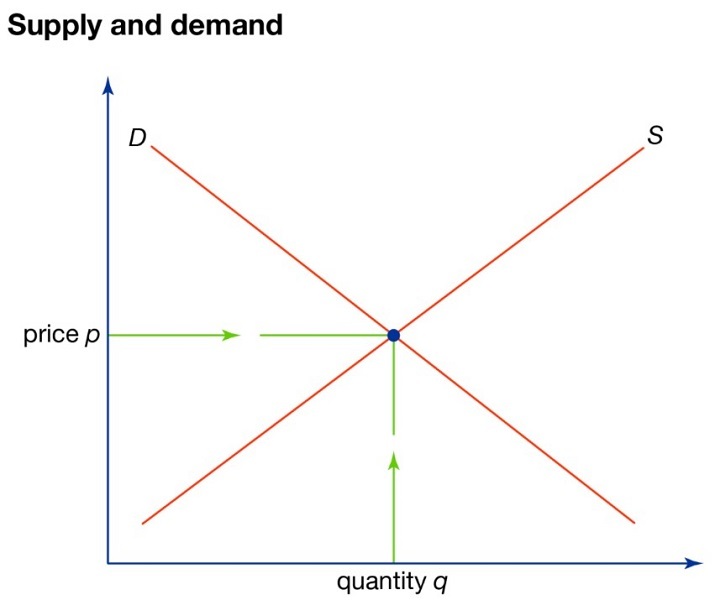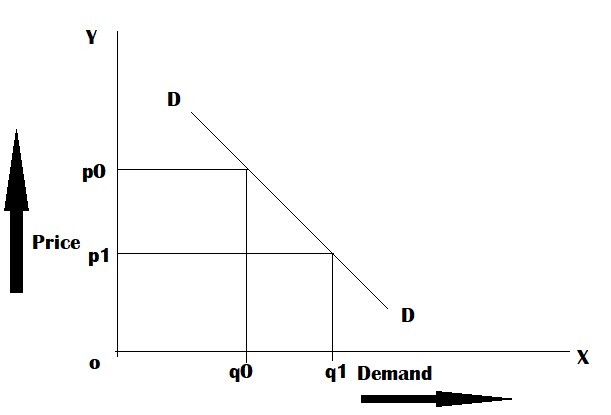
 Data Structure
Data Structure Networking
Networking RDBMS
RDBMS Operating System
Operating System Java
Java MS Excel
MS Excel iOS
iOS HTML
HTML CSS
CSS Android
Android Python
Python C Programming
C Programming C++
C++ C#
C# MongoDB
MongoDB MySQL
MySQL Javascript
Javascript PHP
PHP
- Selected Reading
- UPSC IAS Exams Notes
- Developer's Best Practices
- Questions and Answers
- Effective Resume Writing
- HR Interview Questions
- Computer Glossary
- Who is Who
Market Demand Curve is the Average Revenue Curve
What is a Demand Curve?
The demand curve is a graph that shows the relationship between the price of and the demand for a commodity in the market. The price of the good is usually shown on Y-axis while the demand for the product is placed on the X-axis. This price-quantity relationship can be shown for both individual customers and the markets. When the graph is plotted for the individuals it is called an individual demand curve while when the graph depicts the market condition it is called a market demand curve.

Demand curves usually slope downwards because, with increasing prices, the demand for products goes down. This is, however, not applicable to Giffen goods, Veblen goods, and speculative bubbles wherein buyers are interested toward a good or a commodity even if its price rises.
Demand curves are usually used to check the behavior of competitive markets where the curves are placed with supply curves. The placement of both demand and supply curves provides equilibrium positions at which sellers and buyers agree on the price of commodities to sell and buy the products respectively. The plotting of both supply and demand also shows the equilibrium quantity of products that will be bought and sold by the buyers and sellers respectively without any shortages or excess of products left in the market.
Movement along the demand curve shows how the demand will change when the price of a good or commodity is changed. There is a phenomenon called a shift of demand curve which occurs when the price remains constant but demand changes due to any other factor, such as advertising, marketing campaigns, etc.
Usually, the factors that change the position of the demand curve are not in the demand curve. So, the curve shifts to a completely new position when these factors impact the price-demand curve.
A variety of techniques may be used to determine the values of the X and Y components of the demand curve. Usual techniques include collecting data on prices, quantities, and other variables, such as product quality and consumer income that affect demand. Statistical methods and multiple regression are applied to adjudge the data obtained in some instances while in others data are taken from consumer surveys and experiments.
Assumptions Underlying Derivation of Demand Curve
The income of the consumer does not change or remains constant.
The price of other goods that are related remains constant.
Preferences, habits, tastes, and fashions do not change while depicting the curve.
The number of buyers in the market remains constant.
The commodity must be a normal good and it should not have any status value.
Categories of Demand Curves
Demand curves are divided into three categories:
The individual demand curve is the demand curve of an individual which depicts the price of a commodity he uses against the demand of the commodity.
The market demand curve is the demand curve of a market. It is depicted as the total demand of the individuals in a given market against the total price of the item. Market demand can be derived by adding individual demands horizontally.
The firm demand curve shows the demand curve of the market to which a firm is exposed. It expresses the number of customers willing to buy from the enterprise and the price.
Market Demand Curve is the Average Revenue Curve

In the figure above, at the price point p0, the demand is q0. At another point of price p1, the demand for the product is q1. It is observable that at a higher demand point q1, the price is at a lower level of q1. That shows that the demand for a product goes down when the price of the product increases. Alternatively, when the price of a product goes down, its demand increases automatically.
The figure implies that the cost price of an item influences the demand for that item in the marketplace. With a gradual increase in prices, the demand shifts to a lower value. We can therefore place the values of demand against prices to obtain a straight line in the case of the market demand curve. It is also quoted as the decreasing demand function of the cost price of the market demand curve.
It is also noticeable via the depiction that for the monopoly enterprise, the decision regarding price is the most contributing factor to the amounts sold by the firm. If the monopoly firm introduces its products at a higher price, it will be able to sell fewer goods than usual.
Similarly, if it wants to sell more of its products, it must release the products at a lower price. Therefore, for a monopoly enterprise, the cost price is a function of the demand in the market. Moreover, there is an inverse relationship between the cost price of an item and its demand in the market. The market demand, therefore, can be twisted by a monopoly firm by utilizing the optimal number of products released in the market.
-
The overall judgment can also be expressed by stating that the cost price is a decreasing function of the commodities sold. This means that a monopoly firm can sell more goods when it lowers the prices. This means that the average revenue earned by the company will depend on the cost price and therefore, the goods sold by the monopoly firm.
In other words, the monopoly firm will obey the same rule as we move from top to bottom along the depicted straight line on the graph. The monopoly firm will therefore show the same relationship in the case of average revenue and market demand when the graphs are plotted on the graph paper.
We can, therefore, state that the market demand curve is the average revenue curve of a monopoly firm in the market conditions. The rule of demand and price apply to both in exactly the same manner whichever way it is looked upon.
Conclusion
It is a fundamental concept in economics that the market demand curve is the average revenue curve of a monopoly firm. This has wide-ranging effects on various economic situations. It also helps in understanding the market demand curves better as average revenue is often better understood by laymen than market demand graphs. That is why it is important to see why market demand and average revenue curves are the same.
FAQs
Qns 1. How many categories of demand curves are there?
Ans. There are three categories - individual, market, and firm demand curves.
Qns 2. Which parameters are placed on the X and Y axis of demand curves?
Ans. Price is placed on the Y axis and demand is placed on the X-axis of a demand curve.
Qns 3. What happens when other factors affect the demand curve?
Ans. When other factors than price and demand affect the demand curve the curve shifts the position.

